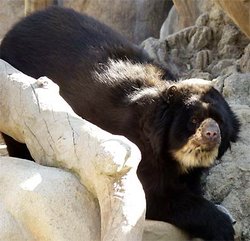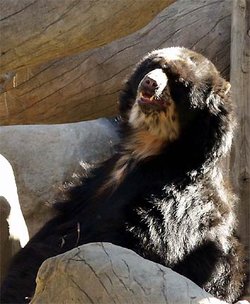Sun Bear
|
|
| Sun Bear Conservation status: Vulnerable | ||||||||||||||
|---|---|---|---|---|---|---|---|---|---|---|---|---|---|---|
| Missing image Sun_Bear.jpg Sun Bear Sun Bear | ||||||||||||||
| Scientific classification | ||||||||||||||
| ||||||||||||||
| Binomial name | ||||||||||||||
| Ursus (Helarctos) malayanus (Raffles, 1821) |
The sun bear, Ursus malayanus, is found primarily in the tropical rainforests of Southeast Asia.
The sun bear stands approximately four feet (1.2 m) in length, making it the smallest member in the bear family. It is often called the dog bear because of its small stature. It has a two-inch (3 cm) tail and on average weighs less than 145 pounds (65 kg). Males tend to be slightly larger than females.
Unlike other bears, the sun bear's fur is short and sleek. This adaptation is probably due to the lowland climates it inhabits. Dark black or brown-black fur covers its body, except on the chest where there is a pale orange-yellow marking in the shape of a horseshoe. Similar colored fur can be found around the muzzle and the eyes. This distinct marking gives the sun bear its name.
Sun bears possess sickle-shaped claws that are relatively light in weight. They have large paws with naked soles, probably to assist in climbing. Their inward-turned feet make the bears walk pigeon-toed, but they are excellent climbers.
They have small, round ears and a short muzzle.
As primarily nocturnal creatures, the sun bears tend to rest during the day on lower limbs not far above the ground. Because they spend so much time in trees, sun bears can sometimes cause a good amount of damage to private property. They have been known to destroy coconut palms and cocoa trees on plantations. Hunting of nuisance bears is a major cause for the recent decline in the sun bear population, as well as poaching for its fur and for use in Chinese medicine.
The diet of the sun bear varies widely and includes small vertebrates such as lizards, birds, or other mammals, in addition to fruits, eggs, termites, the young tips of palm trees, nests of bees, berries, sprouts, insects, roots, cocoa and coconuts. Their powerful jaws can crack open coconuts. Much of the sun bear's food must be detected using their keen sense of smell as their sight is poor.
Sun bears do not hibernate; because of this, they can reproduce year-round. It is not uncommon for them to give birth to two cubs at a time weighing approximately 10-12 ounces (280 to 340 g) each. The gestation period is about 96 days, but they suckle for about 18 months. The offspring reach sexual maturity after 3-4 years, and they live up to 28 years in captivity.
There is one subspecies of sun bear (Helarctos malayanus euryspilus), found only on the island of Borneo.
The Malayan name for the sun bear is ‘basindo nan tenggil’, which is translated as ‘he who likes to sit high’.
Pictures of Bears
- Pictures of Bears (http://classroomclipart.com/cgi-bin/kids/imageFolio.cgi?direct=Animals/Bears)
- Bear Clipart (http://classroomclipart.com/cgi-bin/kids/imageFolio.cgi?direct=Clipart/Animals/Bear_Clipart)
Clipart and Animal Pictures
- Clipart (https://classroomclipart.com/image/category/clipart.htm)
- Animal Clipart (https://classroomclipart.com/image/category/animal-clipart.htm)
- Animal Animated Clipart (https://classroomclipart.com/clipart/Animations/Animals.htm)
- Pictures of Animals (https://classroomclipart.com/image/category/animal-photos.htm)
- Amphibian Clip Art, Pictures and Photogaphs (https://classroomclipart.com/image/category/amphibian-clipart.htm)
- Farm Animal Clip Art, Pictures and Photographs (https://classroomclipart.com/image/category/farm-animal-clipart.htm)
- Mammal Clip Art, Pictures and Photographs (https://classroomclipart.com/image/category/mammal-clipart.htm)
- Marine Animal Clip Art, Pictures and Photographs (https://classroomclipart.com/image/category/marine-life-clipart.htm)
- Reptile Clip Art, Pictures and Photographs (https://classroomclipart.com/image/category/reptile-clipart.htm)
- Spider Clip Art, Pictures and Photographs (https://classroomclipart.com/image/category/spider-clipart.htm)
External links
- Woodland Park Zoo, Seattle, Washington, USA (http://www.zoo.org/educate/fact_sheets/sun_bear/sbear.htm)
- Bear Den (http://www.bearden.org/sunbear.html)
- Animal Tracks (http://exn.ca/AnimalTracks/SunBears/)
- Wellington Zoo (http://www.wellingtonzoo.com/animals/mammals/sunbear.html)



